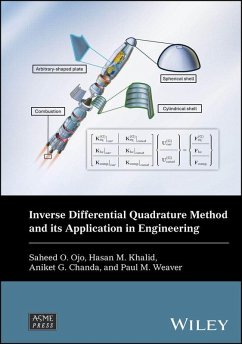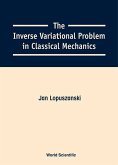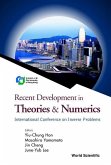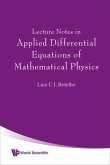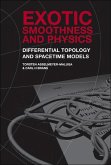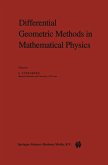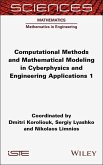Saheed Olalekan Ojo, Hasan M Khalid, Aniket Gopa Chanda, Paul M Weaver
Inverse Differential Quadrature Method and Its Application in Engineering
Saheed Olalekan Ojo, Hasan M Khalid, Aniket Gopa Chanda, Paul M Weaver
Inverse Differential Quadrature Method and Its Application in Engineering
- Gebundenes Buch
- Merkliste
- Auf die Merkliste
- Bewerten Bewerten
- Teilen
- Produkt teilen
- Produkterinnerung
- Produkterinnerung
Inverse Differential Quadrature Method and its Application in Engineering Authoritative reference introducing iDQM as a numerical tool to accurately perform high fidelity analyses efficiently for solving problems in engineering governed by higher-order ordinary and partial differential equations. Inverse Differential Quadrature Method and its Application in Engineering is the first book to comprehensively cover the development of a new numerical solution technique: the inverse differential quadrature method (iDQM), as an indirect approximation technique that can circumvent numerical…mehr
Andere Kunden interessierten sich auch für
![The Inverse Variational Problem in Classical Mechanics The Inverse Variational Problem in Classical Mechanics]() Jan LopuszanskiThe Inverse Variational Problem in Classical Mechanics106,99 €
Jan LopuszanskiThe Inverse Variational Problem in Classical Mechanics106,99 €![Recent Development in Theories and Numerics, Proceedings of the International Conference on Inverse Problems Recent Development in Theories and Numerics, Proceedings of the International Conference on Inverse Problems]() Recent Development in Theories and Numerics, Proceedings of the International Conference on Inverse Problems235,99 €
Recent Development in Theories and Numerics, Proceedings of the International Conference on Inverse Problems235,99 €![Lecture Notes in Applied Differential Equations of Mathematical Physics Lecture Notes in Applied Differential Equations of Mathematical Physics]() Luiz C L BotelhoLecture Notes in Applied Differential Equations of Mathematical Physics97,99 €
Luiz C L BotelhoLecture Notes in Applied Differential Equations of Mathematical Physics97,99 €![Twenty Years of Bialowieza: A Mathematical Anthology: Aspects of Differential Geometric Methods in Physics Twenty Years of Bialowieza: A Mathematical Anthology: Aspects of Differential Geometric Methods in Physics]() Twenty Years of Bialowieza: A Mathematical Anthology: Aspects of Differential Geometric Methods in Physics160,99 €
Twenty Years of Bialowieza: A Mathematical Anthology: Aspects of Differential Geometric Methods in Physics160,99 €![Exotic Smoothness and Physics: Differential Topology and Spacetime Models Exotic Smoothness and Physics: Differential Topology and Spacetime Models]() Torsten Asselmeyer-MalugaExotic Smoothness and Physics: Differential Topology and Spacetime Models125,99 €
Torsten Asselmeyer-MalugaExotic Smoothness and Physics: Differential Topology and Spacetime Models125,99 €![Differential Geometric Methods in Mathematical Physics Differential Geometric Methods in Mathematical Physics]() S. Sternberg (Hrsg.)Differential Geometric Methods in Mathematical Physics115,99 €
S. Sternberg (Hrsg.)Differential Geometric Methods in Mathematical Physics115,99 €![Computational Methods and Mathematical Modeling in Cyberphysics and Engineering Applications 1 Computational Methods and Mathematical Modeling in Cyberphysics and Engineering Applications 1]() D KorolioukComputational Methods and Mathematical Modeling in Cyberphysics and Engineering Applications 1147,99 €
D KorolioukComputational Methods and Mathematical Modeling in Cyberphysics and Engineering Applications 1147,99 €-
-
-
Inverse Differential Quadrature Method and its Application in Engineering Authoritative reference introducing iDQM as a numerical tool to accurately perform high fidelity analyses efficiently for solving problems in engineering governed by higher-order ordinary and partial differential equations. Inverse Differential Quadrature Method and its Application in Engineering is the first book to comprehensively cover the development of a new numerical solution technique: the inverse differential quadrature method (iDQM), as an indirect approximation technique that can circumvent numerical differentiation-induced errors in the solution of systems of higher-order differential equations. The book's introduction highlights the historical development of numerical methods in the field while emphasising the significance of strong-form solution methods. Detailed derivations of iDQM formulations in one- and two-dimensions, approximation procedures, and error quantification are described. The subsequent chapters describe the application of iDQM to many fields of engineering including structures, heat flow, fluids, waves and multiphysics problems. Example applications covering linear and nonlinear systems are demonstrated with simple and detailed discretisation steps to aid reader understanding of iDQM. MATLAB codes for many of the illustrative examples in the book are provided to ease implementation and practice for readers. Written by a team of highly qualified academics, Inverse Differential Quadrature Method and its Application in Engineering discusses topics including: * High fidelity linear and non-linear structural analyses of variable-stiffness curved beams, arbitrary-shaped plates, and cylindrical and spherical shells governed by unified formulation kinematics * iDQM error formulation and its effect on spectral convergence * Accurate and efficient solutions of non-structural problems governed by, for example, Korteweg-de Vries (KdV) wave, Helmholtz, convection-diffusion and steady state heat conduction equations and nonlinear one- and two-dimensional scalar combustion models * Strategies to alleviate mathematical ill-conditioning of system matrices employing novel preconditioning techniques Inverse Differential Quadrature Method and its Application in Engineering is an essential reference for researchers and engineers performing advanced numerical analysis across a range of applications in the mechanical, aerospace, chemical, and civil engineering industries, along with graduate students in related programs of study.
Produktdetails
- Produktdetails
- Verlag: Wiley
- Seitenzahl: 368
- Erscheinungstermin: 20. Oktober 2025
- Englisch
- ISBN-13: 9781394254125
- ISBN-10: 1394254121
- Artikelnr.: 71977926
- Herstellerkennzeichnung
- Libri GmbH
- Europaallee 1
- 36244 Bad Hersfeld
- gpsr@libri.de
- Verlag: Wiley
- Seitenzahl: 368
- Erscheinungstermin: 20. Oktober 2025
- Englisch
- ISBN-13: 9781394254125
- ISBN-10: 1394254121
- Artikelnr.: 71977926
- Herstellerkennzeichnung
- Libri GmbH
- Europaallee 1
- 36244 Bad Hersfeld
- gpsr@libri.de
Saheed O. Ojo, PhD, is a Research Fellow at the University of Limerick. Hasan M. Khalid, PhD, is a Postdoctoral Researcher at the University of Limerick. Aniket G. Chanda, PhD, is a Postdoctoral Researcher at the University of Limerick. Paul M. Weaver, PhD, is the Bernal Chair of Composite Materials and Structures at the University of Limerick and the Professor of Lightweight Structures at the University of Bristol.
Preface xiii
Nomenclature xv
Acronyms xvi
Acknowledgments xvii
1 Introduction 1
1.1 Introduction 1
1.2 Overview of Numerical Approximation Methods 1
1.3 Numerical Approximation 5
1.4 Spectral Methods 6
1.4.1 Galerkin and Tau Approach 6
1.4.2 Collocation Approach 7
1.5 Differential Quadrature Method 8
1.5.1 Determination of Weighting Coefficients 8
1.5.2 DQM Implementation of Dual Boundary Conditions 10
1.6 Errors Incurred in Numerical Differentiation 11
1.7 Indirect Approximation Approach 12
1.8 Conclusion 12
References 13
2 Inverse Differential Quadrature Method 19
2.1 Introduction 19
2.2 Brief Description of DQM Formulation 19
2.3 Inverse Differential Quadrature Method 21
2.3.1 First-order iDQM-by-integration 21
2.3.2 Higher-order iDQM-by-integration 22
2.3.3 Computational Aspects of iDQM-by-integration 22
2.3.4 First-order iDQM-by-inversion 23
2.3.5 Higher-order iDQM-by-inversion 23
2.3.6 Proof of y m = m!¿D (ym) 1 25
2.4 iDQM Error Formulation 26
2.4.1 Error Formulation of iDQM-by-integration 26
2.4.2 Error of iDQM-by-inversion 28
2.4.3 Comparison of iDQM Error with DQM Error 30
2.5 Two-dimensional iDQM 31
2.5.1 First-order iDQM 32
2.5.2 Second-order iDQM 33
2.5.3 Higher-order iDQM 34
2.6 Discretisation of ODEs and PDEs 35
2.6.1 One-dimensional iDQM Discretisation 35
2.6.2 Two-dimensional iDQM Discretisation 36
2.7 Numerical Examples 37
2.7.1 Approximation of a Function and Its Derivatives 38
2.7.2 Numerical Solution of Euler Cantilever Beam (ODE) 39
2.7.3 Solution of Simply Supported Isotropic Plate Under Sinusoidally
Distributed Load (PDE) 40
2.7.4 Error Analysis (Measure of Numerical Accuracy) 42
2.7.5 Error Propagation (Measure of Numerical Stability) 42
2.8 Conclusion 43
References 44
3 Application to Beam Structures 45
3.1 Introduction 45
3.2 Euler Beam 46
3.2.1 Euler Beam Formulation 47
3.2.2 iDQM Discretisation 47
3.2.3 Static Solution of Euler Beam 50
3.2.4 Buckling Solution of Euler Beam 52
3.2.5 Free Vibration Solution of Euler Beam 53
3.3 Timoshenko Curved Laminated Beam 54
3.3.1 Timoshenko Beam Formulation for Laminated Curved Beams 55
3.3.2 iDQM Discretisation 59
3.3.3 Static Analysis of Laminated Beams 63
3.3.3.1 Static Solution of Laminated Curved Beams 64
3.3.3.2 Static Solution of VS Straight Beams 65
3.3.4 Transient and Free Vibration Analyses of Laminated Curved Beams 67
3.3.4.1 Free Vibration Solution of Laminated Curved Beams 68
3.3.4.2 Transient Solution of Laminated Curved Beams 73
3.4 UF Beam 75
3.4.1 Strong Unified Formulation 75
3.4.2 iDQM Discretisation 78
3.4.3 Static Analysis of 3D Laminated Beams 82
3.4.3.1 Static Solution of 3D Symmetric Cross-ply Laminated Beam 83
3.4.3.2 Static Solution of 3D Non-symmetric Cross-ply Laminated Beam 85
3.4.3.3 Static Solution of 3D Sandwich Laminated Beam 88
3.4.4 Buckling Analysis of 3D Laminated Beams 88
3.4.4.1 Buckling Solution of 3D Laminated Beams 92
3.4.4.2 Buckling Solution of 3D VS Laminated Beams 93
3.4.5 Free Vibration Analysis of 3D Laminated Beams 94
3.4.5.1 Free Vibration Solution of 3D Laminated Beams 95
3.4.5.2 Free Vibration Solution of 3D VS Laminated Beams 95
3.5 Conclusion 97
References 97
4 Application to Plate Structures 99
4.1 Introduction 99
4.2 FSDT Formulation for Laminated Plate 100
4.3 iDQM Discretisation 102
4.4 Bending Analysis 105
4.4.1 Static Solution of Laminated Plates 106
4.4.2 Convergence Analysis 110
4.5 Buckling Analysis 111
4.5.1 Buckling Solution of Laminated Plates 112
4.5.2 Convergence Analysis 113
4.6 Free Vibration Analysis of Arbitrary-shaped Plates 115
4.6.1 Geometric Mapping 116
4.6.2 Transformed Discretised Equations 119
4.6.3 Free Vibration of Square Plates 120
4.6.4 Free Vibration of Skew Plates 120
4.6.4.1 Free Vibration of Isotropic Skew Plates 120
4.6.4.2 Free Vibration of Clamped-clamped Composite Skew Plates 122
4.6.5 Free Vibration of Circular Plates 124
4.6.5.1 Free Vibration of Isotropic Circular Plates 124
4.6.5.2 Free Vibration of Composite Circular Plates 125
4.6.6 Free Vibration of Annular Sector Plates 125
4.6.6.1 Free Vibration of Isotropic Annular Sector Plates 125
4.6.6.2 Free Vibration of Laminated Annular Sector Plates 127
4.6.7 Convergence Analysis 128
4.7 Transient Analysis 132
4.7.1 Transient Analysis of Laminated Plates 133
4.7.1.1 Transient Analysis of Laminated Plates Under Step Load 133
4.7.1.2 Transient Analysis of Laminated Plates Under Arbitrary Loading
Conditions 134
4.7.2 Convergence Analysis 139
4.8 Conclusion 140
References 141
5 Application to Shell Structures 143
5.1 Introduction 143
5.2 Shell Unified Formulation 144
5.2.1 Strong Shell Unified Formulation 144
5.2.2 iDQM Discretisation 149
5.2.3 Static Solution of Laminated Cylindrical and Spherical Shells 156
5.2.3.1 Static Analysis of Laminated Composite Spherical Shell Subject to
Bi-sinusoidal Load-1 157
5.2.3.2 Static Analysis of Spherical Laminated Composite Shell Subject to
Bi-sinusoidal Load- 2 164
5.2.3.3 Static Analysis of Laminated Composite Cylindrical Shell Subject to
Bi-sinusoidal Load 166
5.2.3.4 Static Analysis of Laminated Composite Cylindrical Shell in
Cylindrical Bending 170
5.2.3.5 Static Analysis of Isotropic Sandwich Cylindrical Shell with
Isotropic Face Sheets Subject to Bi-sinusoidal Load 172
5.2.4 Free Vibration Solution of Laminated Cylindrical and Spherical Shells
178
5.2.4.1 Free Vibration of Laminated Composite Spherical Shell with Various
Deepness and Span-to-thickness Ratios 180
5.2.4.2 Free Vibration of Laminated Composite Cylindrical Shell with
Various Deepness and Span-thickness Ratios 180
5.3 Conclusion 184
References 184
6 Application to Multidomain Structures 187
6.1 Introduction 187
6.2 Multidomain iDQM for Beam Structures 187
6.2.1 Beam Formulation for a Subdomain 187
6.2.2 Assembly Procedure 188
6.2.3 Compatibility Conditions 189
6.2.4 Static Solution of Beam Under Point Load 190
6.3 Multidomain iDQM for Plate Structures 191
6.3.1 Plate Formulation for a Subdomain 193
6.3.2 Assembly Procedure 193
6.3.3 Compatibility Conditions 194
6.3.4 Solution of Bending of Plate Under a Patch Load 195
6.3.5 Solution of Bending of Plates Comprising Dissimilar Materials 197
6.3.6 Solution of Bending of Plate with Discontinuous Boundaries 200
6.4 Conclusion 202
References 203
7 Application to Nonlinear Problems 205
7.1 Introduction 205
7.2 One-dimensional Problems 205
7.2.1 Nonlinear Flexural Vibration of a Simply Supported Euler Beam 206
7.2.2 Nonlinear Flexural Vibration of SS Timoshenko Beam 209
7.2.3 Nonlinear Flexural Vibration of Clamped-clamped Timoshenko Beam 216
7.2.4 Steady-state Heat Conduction in Slab with Temperature-dependent
Conductivity 216
7.2.5 One-dimensional Scalar Combustion Model 220
7.2.6 Soliton Solutions to the Korteweg-de Vries Equation 224
7.2.7 Solution of the Interaction Between Two Solitons 226
7.2.8 Solution of the Interaction Between Three Solitons 229
7.3 Two-dimensional Problems 231
7.3.1 Nonlinear Bending Analysis of Isotropic SS Square Plates 231
7.3.2 Nonlinear Bending Analysis of Isotropic Fully Clamped Square Plate
240
7.3.3 2D Scalar Combustion Model 242
7.4 Conclusion 245
References 246
8 Application to Miscellaneous Problems 249
8.1 Introduction 249
8.2 One-dimensional Problems 249
8.2.1 Thermomechanical Formulation for Laminated Beams 249
8.2.1.1 Static Analysis of Laminated Beams Subject to Thermal Load 254
8.2.1.2 Static Solution of Composite Beam Integrated with Piezoelectric
Actuator Subject to Electromechanical Load 256
8.2.2 Solution of Chemical Reactor Equation 259
8.2.3 1D Time-dependent Heat Diffusion in a Sphere 261
8.3 Two-dimensional Problems 265
8.3.1 Solution of Convection-diffusion Equation 265
8.3.2 Solution of Vorticity-stream Function Equations 268
8.3.3 Solution of Helmholtz Equation 274
8.4 Conclusion 279
References 279
9 Preconditioning of iDQM Systems of Equations 281
9.1 Introduction 281
9.2 iDQM Preconditioning 282
9.3 Preconditioning by Normalisation 282
9.3.1 Formulation for Linear Time-independent Systems 283
9.3.1.1 Static Response of Simply Supported Plate Under Sinusoidally
Distributed Load 284
9.3.1.2 Static Response of SS Plate Under Uniformly Distributed Load 284
9.3.1.3 Stress Prediction of SS 3D Laminated Beam Under Sinusoidally
Distributed Load 288
9.3.2 Formulation for Linear Second-order Time-dependent Systems 293
9.3.2.1 Transient Response of SS Timoshenko Beam Under Time-dependent
Uniformly Distributed Load 295
9.3.3 Formulation for Nonlinear Systems 296
9.3.3.1 Geometrically Nonlinear Bending Analysis of SS Isotropic Plate
under Large Uniform Pressure Load 296
9.3.3.2 Geometrically Nonlinear Bending Analysis of Clamped Isotropic Plate
under Large Uniform Pressure Load 297
9.4 Preconditioning by Matrix Inversion 298
9.5 Preconditioning by Matrix Inversion and Normalisation 299
9.5.1 Separation of Constants and Normalisation (PMN-Method 1) 299
9.5.2 Separation of Constants and Boundaries and Normalisation (PMN-Method
2) 300
9.5.2.1 Buckling Analysis of SS Euler Beam 302
9.5.2.2 Buckling Solution of SS FSDT Plate 303
9.5.2.3 Free Vibration Analysis of SS Euler Beam 305
9.5.2.4 Free Vibration Analysis of SS FSDT Plate 305
9.6 Comparison of Computational Complexities of Preconditioning Methods 306
9.7 Conclusion 309
References 310
10 Discussion on iDQM Convergence 311
10.1 Introduction 311
10.2 Convergence Analysis 312
10.2.1 Convergence of iDQM for Static Analysis 313
10.2.1.1 Convergence of Bending Solution for Euler Beam 313
10.2.1.2 Convergence of Bending Solution for FSDT Plate 317
10.2.2 Convergence of iDQM for Buckling Analysis 318
10.2.2.1 Convergence of Buckling Solution for Euler Column 320
10.2.2.2 Convergence of Buckling Solution for FSDT Plate 321
10.2.3 Convergence of iDQM for Free Vibration Analysis 322
10.2.3.1 Convergence of Free Vibration Solution for Euler Column 323
10.2.3.2 Convergence of Free Vibration Solution for FSDT Plate 325
10.2.4 Convergence of iDQM for Analysis Linear Time-dependent Systems 325
10.2.4.1 Convergence of Transient Solution for Laminated Curved Timoshenko
Beam 327
10.2.4.2 Convergence of Transient Solution for FSDT Plate 327
10.2.4.3 Convergence of One-dimensional Time-dependent Heat Diffusion in a
Sphere 332
10.2.5 Convergence of Nonlinear Time-dependent Systems (Soliton Solution of
Korteweg-de Vries Wave Equation) 332
10.3 General Discussion on iDQM Convergence 335
10.4 Conclusion 339
References 340
Index 343
Nomenclature xv
Acronyms xvi
Acknowledgments xvii
1 Introduction 1
1.1 Introduction 1
1.2 Overview of Numerical Approximation Methods 1
1.3 Numerical Approximation 5
1.4 Spectral Methods 6
1.4.1 Galerkin and Tau Approach 6
1.4.2 Collocation Approach 7
1.5 Differential Quadrature Method 8
1.5.1 Determination of Weighting Coefficients 8
1.5.2 DQM Implementation of Dual Boundary Conditions 10
1.6 Errors Incurred in Numerical Differentiation 11
1.7 Indirect Approximation Approach 12
1.8 Conclusion 12
References 13
2 Inverse Differential Quadrature Method 19
2.1 Introduction 19
2.2 Brief Description of DQM Formulation 19
2.3 Inverse Differential Quadrature Method 21
2.3.1 First-order iDQM-by-integration 21
2.3.2 Higher-order iDQM-by-integration 22
2.3.3 Computational Aspects of iDQM-by-integration 22
2.3.4 First-order iDQM-by-inversion 23
2.3.5 Higher-order iDQM-by-inversion 23
2.3.6 Proof of y m = m!¿D (ym) 1 25
2.4 iDQM Error Formulation 26
2.4.1 Error Formulation of iDQM-by-integration 26
2.4.2 Error of iDQM-by-inversion 28
2.4.3 Comparison of iDQM Error with DQM Error 30
2.5 Two-dimensional iDQM 31
2.5.1 First-order iDQM 32
2.5.2 Second-order iDQM 33
2.5.3 Higher-order iDQM 34
2.6 Discretisation of ODEs and PDEs 35
2.6.1 One-dimensional iDQM Discretisation 35
2.6.2 Two-dimensional iDQM Discretisation 36
2.7 Numerical Examples 37
2.7.1 Approximation of a Function and Its Derivatives 38
2.7.2 Numerical Solution of Euler Cantilever Beam (ODE) 39
2.7.3 Solution of Simply Supported Isotropic Plate Under Sinusoidally
Distributed Load (PDE) 40
2.7.4 Error Analysis (Measure of Numerical Accuracy) 42
2.7.5 Error Propagation (Measure of Numerical Stability) 42
2.8 Conclusion 43
References 44
3 Application to Beam Structures 45
3.1 Introduction 45
3.2 Euler Beam 46
3.2.1 Euler Beam Formulation 47
3.2.2 iDQM Discretisation 47
3.2.3 Static Solution of Euler Beam 50
3.2.4 Buckling Solution of Euler Beam 52
3.2.5 Free Vibration Solution of Euler Beam 53
3.3 Timoshenko Curved Laminated Beam 54
3.3.1 Timoshenko Beam Formulation for Laminated Curved Beams 55
3.3.2 iDQM Discretisation 59
3.3.3 Static Analysis of Laminated Beams 63
3.3.3.1 Static Solution of Laminated Curved Beams 64
3.3.3.2 Static Solution of VS Straight Beams 65
3.3.4 Transient and Free Vibration Analyses of Laminated Curved Beams 67
3.3.4.1 Free Vibration Solution of Laminated Curved Beams 68
3.3.4.2 Transient Solution of Laminated Curved Beams 73
3.4 UF Beam 75
3.4.1 Strong Unified Formulation 75
3.4.2 iDQM Discretisation 78
3.4.3 Static Analysis of 3D Laminated Beams 82
3.4.3.1 Static Solution of 3D Symmetric Cross-ply Laminated Beam 83
3.4.3.2 Static Solution of 3D Non-symmetric Cross-ply Laminated Beam 85
3.4.3.3 Static Solution of 3D Sandwich Laminated Beam 88
3.4.4 Buckling Analysis of 3D Laminated Beams 88
3.4.4.1 Buckling Solution of 3D Laminated Beams 92
3.4.4.2 Buckling Solution of 3D VS Laminated Beams 93
3.4.5 Free Vibration Analysis of 3D Laminated Beams 94
3.4.5.1 Free Vibration Solution of 3D Laminated Beams 95
3.4.5.2 Free Vibration Solution of 3D VS Laminated Beams 95
3.5 Conclusion 97
References 97
4 Application to Plate Structures 99
4.1 Introduction 99
4.2 FSDT Formulation for Laminated Plate 100
4.3 iDQM Discretisation 102
4.4 Bending Analysis 105
4.4.1 Static Solution of Laminated Plates 106
4.4.2 Convergence Analysis 110
4.5 Buckling Analysis 111
4.5.1 Buckling Solution of Laminated Plates 112
4.5.2 Convergence Analysis 113
4.6 Free Vibration Analysis of Arbitrary-shaped Plates 115
4.6.1 Geometric Mapping 116
4.6.2 Transformed Discretised Equations 119
4.6.3 Free Vibration of Square Plates 120
4.6.4 Free Vibration of Skew Plates 120
4.6.4.1 Free Vibration of Isotropic Skew Plates 120
4.6.4.2 Free Vibration of Clamped-clamped Composite Skew Plates 122
4.6.5 Free Vibration of Circular Plates 124
4.6.5.1 Free Vibration of Isotropic Circular Plates 124
4.6.5.2 Free Vibration of Composite Circular Plates 125
4.6.6 Free Vibration of Annular Sector Plates 125
4.6.6.1 Free Vibration of Isotropic Annular Sector Plates 125
4.6.6.2 Free Vibration of Laminated Annular Sector Plates 127
4.6.7 Convergence Analysis 128
4.7 Transient Analysis 132
4.7.1 Transient Analysis of Laminated Plates 133
4.7.1.1 Transient Analysis of Laminated Plates Under Step Load 133
4.7.1.2 Transient Analysis of Laminated Plates Under Arbitrary Loading
Conditions 134
4.7.2 Convergence Analysis 139
4.8 Conclusion 140
References 141
5 Application to Shell Structures 143
5.1 Introduction 143
5.2 Shell Unified Formulation 144
5.2.1 Strong Shell Unified Formulation 144
5.2.2 iDQM Discretisation 149
5.2.3 Static Solution of Laminated Cylindrical and Spherical Shells 156
5.2.3.1 Static Analysis of Laminated Composite Spherical Shell Subject to
Bi-sinusoidal Load-1 157
5.2.3.2 Static Analysis of Spherical Laminated Composite Shell Subject to
Bi-sinusoidal Load- 2 164
5.2.3.3 Static Analysis of Laminated Composite Cylindrical Shell Subject to
Bi-sinusoidal Load 166
5.2.3.4 Static Analysis of Laminated Composite Cylindrical Shell in
Cylindrical Bending 170
5.2.3.5 Static Analysis of Isotropic Sandwich Cylindrical Shell with
Isotropic Face Sheets Subject to Bi-sinusoidal Load 172
5.2.4 Free Vibration Solution of Laminated Cylindrical and Spherical Shells
178
5.2.4.1 Free Vibration of Laminated Composite Spherical Shell with Various
Deepness and Span-to-thickness Ratios 180
5.2.4.2 Free Vibration of Laminated Composite Cylindrical Shell with
Various Deepness and Span-thickness Ratios 180
5.3 Conclusion 184
References 184
6 Application to Multidomain Structures 187
6.1 Introduction 187
6.2 Multidomain iDQM for Beam Structures 187
6.2.1 Beam Formulation for a Subdomain 187
6.2.2 Assembly Procedure 188
6.2.3 Compatibility Conditions 189
6.2.4 Static Solution of Beam Under Point Load 190
6.3 Multidomain iDQM for Plate Structures 191
6.3.1 Plate Formulation for a Subdomain 193
6.3.2 Assembly Procedure 193
6.3.3 Compatibility Conditions 194
6.3.4 Solution of Bending of Plate Under a Patch Load 195
6.3.5 Solution of Bending of Plates Comprising Dissimilar Materials 197
6.3.6 Solution of Bending of Plate with Discontinuous Boundaries 200
6.4 Conclusion 202
References 203
7 Application to Nonlinear Problems 205
7.1 Introduction 205
7.2 One-dimensional Problems 205
7.2.1 Nonlinear Flexural Vibration of a Simply Supported Euler Beam 206
7.2.2 Nonlinear Flexural Vibration of SS Timoshenko Beam 209
7.2.3 Nonlinear Flexural Vibration of Clamped-clamped Timoshenko Beam 216
7.2.4 Steady-state Heat Conduction in Slab with Temperature-dependent
Conductivity 216
7.2.5 One-dimensional Scalar Combustion Model 220
7.2.6 Soliton Solutions to the Korteweg-de Vries Equation 224
7.2.7 Solution of the Interaction Between Two Solitons 226
7.2.8 Solution of the Interaction Between Three Solitons 229
7.3 Two-dimensional Problems 231
7.3.1 Nonlinear Bending Analysis of Isotropic SS Square Plates 231
7.3.2 Nonlinear Bending Analysis of Isotropic Fully Clamped Square Plate
240
7.3.3 2D Scalar Combustion Model 242
7.4 Conclusion 245
References 246
8 Application to Miscellaneous Problems 249
8.1 Introduction 249
8.2 One-dimensional Problems 249
8.2.1 Thermomechanical Formulation for Laminated Beams 249
8.2.1.1 Static Analysis of Laminated Beams Subject to Thermal Load 254
8.2.1.2 Static Solution of Composite Beam Integrated with Piezoelectric
Actuator Subject to Electromechanical Load 256
8.2.2 Solution of Chemical Reactor Equation 259
8.2.3 1D Time-dependent Heat Diffusion in a Sphere 261
8.3 Two-dimensional Problems 265
8.3.1 Solution of Convection-diffusion Equation 265
8.3.2 Solution of Vorticity-stream Function Equations 268
8.3.3 Solution of Helmholtz Equation 274
8.4 Conclusion 279
References 279
9 Preconditioning of iDQM Systems of Equations 281
9.1 Introduction 281
9.2 iDQM Preconditioning 282
9.3 Preconditioning by Normalisation 282
9.3.1 Formulation for Linear Time-independent Systems 283
9.3.1.1 Static Response of Simply Supported Plate Under Sinusoidally
Distributed Load 284
9.3.1.2 Static Response of SS Plate Under Uniformly Distributed Load 284
9.3.1.3 Stress Prediction of SS 3D Laminated Beam Under Sinusoidally
Distributed Load 288
9.3.2 Formulation for Linear Second-order Time-dependent Systems 293
9.3.2.1 Transient Response of SS Timoshenko Beam Under Time-dependent
Uniformly Distributed Load 295
9.3.3 Formulation for Nonlinear Systems 296
9.3.3.1 Geometrically Nonlinear Bending Analysis of SS Isotropic Plate
under Large Uniform Pressure Load 296
9.3.3.2 Geometrically Nonlinear Bending Analysis of Clamped Isotropic Plate
under Large Uniform Pressure Load 297
9.4 Preconditioning by Matrix Inversion 298
9.5 Preconditioning by Matrix Inversion and Normalisation 299
9.5.1 Separation of Constants and Normalisation (PMN-Method 1) 299
9.5.2 Separation of Constants and Boundaries and Normalisation (PMN-Method
2) 300
9.5.2.1 Buckling Analysis of SS Euler Beam 302
9.5.2.2 Buckling Solution of SS FSDT Plate 303
9.5.2.3 Free Vibration Analysis of SS Euler Beam 305
9.5.2.4 Free Vibration Analysis of SS FSDT Plate 305
9.6 Comparison of Computational Complexities of Preconditioning Methods 306
9.7 Conclusion 309
References 310
10 Discussion on iDQM Convergence 311
10.1 Introduction 311
10.2 Convergence Analysis 312
10.2.1 Convergence of iDQM for Static Analysis 313
10.2.1.1 Convergence of Bending Solution for Euler Beam 313
10.2.1.2 Convergence of Bending Solution for FSDT Plate 317
10.2.2 Convergence of iDQM for Buckling Analysis 318
10.2.2.1 Convergence of Buckling Solution for Euler Column 320
10.2.2.2 Convergence of Buckling Solution for FSDT Plate 321
10.2.3 Convergence of iDQM for Free Vibration Analysis 322
10.2.3.1 Convergence of Free Vibration Solution for Euler Column 323
10.2.3.2 Convergence of Free Vibration Solution for FSDT Plate 325
10.2.4 Convergence of iDQM for Analysis Linear Time-dependent Systems 325
10.2.4.1 Convergence of Transient Solution for Laminated Curved Timoshenko
Beam 327
10.2.4.2 Convergence of Transient Solution for FSDT Plate 327
10.2.4.3 Convergence of One-dimensional Time-dependent Heat Diffusion in a
Sphere 332
10.2.5 Convergence of Nonlinear Time-dependent Systems (Soliton Solution of
Korteweg-de Vries Wave Equation) 332
10.3 General Discussion on iDQM Convergence 335
10.4 Conclusion 339
References 340
Index 343
Preface xiii
Nomenclature xv
Acronyms xvi
Acknowledgments xvii
1 Introduction 1
1.1 Introduction 1
1.2 Overview of Numerical Approximation Methods 1
1.3 Numerical Approximation 5
1.4 Spectral Methods 6
1.4.1 Galerkin and Tau Approach 6
1.4.2 Collocation Approach 7
1.5 Differential Quadrature Method 8
1.5.1 Determination of Weighting Coefficients 8
1.5.2 DQM Implementation of Dual Boundary Conditions 10
1.6 Errors Incurred in Numerical Differentiation 11
1.7 Indirect Approximation Approach 12
1.8 Conclusion 12
References 13
2 Inverse Differential Quadrature Method 19
2.1 Introduction 19
2.2 Brief Description of DQM Formulation 19
2.3 Inverse Differential Quadrature Method 21
2.3.1 First-order iDQM-by-integration 21
2.3.2 Higher-order iDQM-by-integration 22
2.3.3 Computational Aspects of iDQM-by-integration 22
2.3.4 First-order iDQM-by-inversion 23
2.3.5 Higher-order iDQM-by-inversion 23
2.3.6 Proof of y m = m!¿D (ym) 1 25
2.4 iDQM Error Formulation 26
2.4.1 Error Formulation of iDQM-by-integration 26
2.4.2 Error of iDQM-by-inversion 28
2.4.3 Comparison of iDQM Error with DQM Error 30
2.5 Two-dimensional iDQM 31
2.5.1 First-order iDQM 32
2.5.2 Second-order iDQM 33
2.5.3 Higher-order iDQM 34
2.6 Discretisation of ODEs and PDEs 35
2.6.1 One-dimensional iDQM Discretisation 35
2.6.2 Two-dimensional iDQM Discretisation 36
2.7 Numerical Examples 37
2.7.1 Approximation of a Function and Its Derivatives 38
2.7.2 Numerical Solution of Euler Cantilever Beam (ODE) 39
2.7.3 Solution of Simply Supported Isotropic Plate Under Sinusoidally
Distributed Load (PDE) 40
2.7.4 Error Analysis (Measure of Numerical Accuracy) 42
2.7.5 Error Propagation (Measure of Numerical Stability) 42
2.8 Conclusion 43
References 44
3 Application to Beam Structures 45
3.1 Introduction 45
3.2 Euler Beam 46
3.2.1 Euler Beam Formulation 47
3.2.2 iDQM Discretisation 47
3.2.3 Static Solution of Euler Beam 50
3.2.4 Buckling Solution of Euler Beam 52
3.2.5 Free Vibration Solution of Euler Beam 53
3.3 Timoshenko Curved Laminated Beam 54
3.3.1 Timoshenko Beam Formulation for Laminated Curved Beams 55
3.3.2 iDQM Discretisation 59
3.3.3 Static Analysis of Laminated Beams 63
3.3.3.1 Static Solution of Laminated Curved Beams 64
3.3.3.2 Static Solution of VS Straight Beams 65
3.3.4 Transient and Free Vibration Analyses of Laminated Curved Beams 67
3.3.4.1 Free Vibration Solution of Laminated Curved Beams 68
3.3.4.2 Transient Solution of Laminated Curved Beams 73
3.4 UF Beam 75
3.4.1 Strong Unified Formulation 75
3.4.2 iDQM Discretisation 78
3.4.3 Static Analysis of 3D Laminated Beams 82
3.4.3.1 Static Solution of 3D Symmetric Cross-ply Laminated Beam 83
3.4.3.2 Static Solution of 3D Non-symmetric Cross-ply Laminated Beam 85
3.4.3.3 Static Solution of 3D Sandwich Laminated Beam 88
3.4.4 Buckling Analysis of 3D Laminated Beams 88
3.4.4.1 Buckling Solution of 3D Laminated Beams 92
3.4.4.2 Buckling Solution of 3D VS Laminated Beams 93
3.4.5 Free Vibration Analysis of 3D Laminated Beams 94
3.4.5.1 Free Vibration Solution of 3D Laminated Beams 95
3.4.5.2 Free Vibration Solution of 3D VS Laminated Beams 95
3.5 Conclusion 97
References 97
4 Application to Plate Structures 99
4.1 Introduction 99
4.2 FSDT Formulation for Laminated Plate 100
4.3 iDQM Discretisation 102
4.4 Bending Analysis 105
4.4.1 Static Solution of Laminated Plates 106
4.4.2 Convergence Analysis 110
4.5 Buckling Analysis 111
4.5.1 Buckling Solution of Laminated Plates 112
4.5.2 Convergence Analysis 113
4.6 Free Vibration Analysis of Arbitrary-shaped Plates 115
4.6.1 Geometric Mapping 116
4.6.2 Transformed Discretised Equations 119
4.6.3 Free Vibration of Square Plates 120
4.6.4 Free Vibration of Skew Plates 120
4.6.4.1 Free Vibration of Isotropic Skew Plates 120
4.6.4.2 Free Vibration of Clamped-clamped Composite Skew Plates 122
4.6.5 Free Vibration of Circular Plates 124
4.6.5.1 Free Vibration of Isotropic Circular Plates 124
4.6.5.2 Free Vibration of Composite Circular Plates 125
4.6.6 Free Vibration of Annular Sector Plates 125
4.6.6.1 Free Vibration of Isotropic Annular Sector Plates 125
4.6.6.2 Free Vibration of Laminated Annular Sector Plates 127
4.6.7 Convergence Analysis 128
4.7 Transient Analysis 132
4.7.1 Transient Analysis of Laminated Plates 133
4.7.1.1 Transient Analysis of Laminated Plates Under Step Load 133
4.7.1.2 Transient Analysis of Laminated Plates Under Arbitrary Loading
Conditions 134
4.7.2 Convergence Analysis 139
4.8 Conclusion 140
References 141
5 Application to Shell Structures 143
5.1 Introduction 143
5.2 Shell Unified Formulation 144
5.2.1 Strong Shell Unified Formulation 144
5.2.2 iDQM Discretisation 149
5.2.3 Static Solution of Laminated Cylindrical and Spherical Shells 156
5.2.3.1 Static Analysis of Laminated Composite Spherical Shell Subject to
Bi-sinusoidal Load-1 157
5.2.3.2 Static Analysis of Spherical Laminated Composite Shell Subject to
Bi-sinusoidal Load- 2 164
5.2.3.3 Static Analysis of Laminated Composite Cylindrical Shell Subject to
Bi-sinusoidal Load 166
5.2.3.4 Static Analysis of Laminated Composite Cylindrical Shell in
Cylindrical Bending 170
5.2.3.5 Static Analysis of Isotropic Sandwich Cylindrical Shell with
Isotropic Face Sheets Subject to Bi-sinusoidal Load 172
5.2.4 Free Vibration Solution of Laminated Cylindrical and Spherical Shells
178
5.2.4.1 Free Vibration of Laminated Composite Spherical Shell with Various
Deepness and Span-to-thickness Ratios 180
5.2.4.2 Free Vibration of Laminated Composite Cylindrical Shell with
Various Deepness and Span-thickness Ratios 180
5.3 Conclusion 184
References 184
6 Application to Multidomain Structures 187
6.1 Introduction 187
6.2 Multidomain iDQM for Beam Structures 187
6.2.1 Beam Formulation for a Subdomain 187
6.2.2 Assembly Procedure 188
6.2.3 Compatibility Conditions 189
6.2.4 Static Solution of Beam Under Point Load 190
6.3 Multidomain iDQM for Plate Structures 191
6.3.1 Plate Formulation for a Subdomain 193
6.3.2 Assembly Procedure 193
6.3.3 Compatibility Conditions 194
6.3.4 Solution of Bending of Plate Under a Patch Load 195
6.3.5 Solution of Bending of Plates Comprising Dissimilar Materials 197
6.3.6 Solution of Bending of Plate with Discontinuous Boundaries 200
6.4 Conclusion 202
References 203
7 Application to Nonlinear Problems 205
7.1 Introduction 205
7.2 One-dimensional Problems 205
7.2.1 Nonlinear Flexural Vibration of a Simply Supported Euler Beam 206
7.2.2 Nonlinear Flexural Vibration of SS Timoshenko Beam 209
7.2.3 Nonlinear Flexural Vibration of Clamped-clamped Timoshenko Beam 216
7.2.4 Steady-state Heat Conduction in Slab with Temperature-dependent
Conductivity 216
7.2.5 One-dimensional Scalar Combustion Model 220
7.2.6 Soliton Solutions to the Korteweg-de Vries Equation 224
7.2.7 Solution of the Interaction Between Two Solitons 226
7.2.8 Solution of the Interaction Between Three Solitons 229
7.3 Two-dimensional Problems 231
7.3.1 Nonlinear Bending Analysis of Isotropic SS Square Plates 231
7.3.2 Nonlinear Bending Analysis of Isotropic Fully Clamped Square Plate
240
7.3.3 2D Scalar Combustion Model 242
7.4 Conclusion 245
References 246
8 Application to Miscellaneous Problems 249
8.1 Introduction 249
8.2 One-dimensional Problems 249
8.2.1 Thermomechanical Formulation for Laminated Beams 249
8.2.1.1 Static Analysis of Laminated Beams Subject to Thermal Load 254
8.2.1.2 Static Solution of Composite Beam Integrated with Piezoelectric
Actuator Subject to Electromechanical Load 256
8.2.2 Solution of Chemical Reactor Equation 259
8.2.3 1D Time-dependent Heat Diffusion in a Sphere 261
8.3 Two-dimensional Problems 265
8.3.1 Solution of Convection-diffusion Equation 265
8.3.2 Solution of Vorticity-stream Function Equations 268
8.3.3 Solution of Helmholtz Equation 274
8.4 Conclusion 279
References 279
9 Preconditioning of iDQM Systems of Equations 281
9.1 Introduction 281
9.2 iDQM Preconditioning 282
9.3 Preconditioning by Normalisation 282
9.3.1 Formulation for Linear Time-independent Systems 283
9.3.1.1 Static Response of Simply Supported Plate Under Sinusoidally
Distributed Load 284
9.3.1.2 Static Response of SS Plate Under Uniformly Distributed Load 284
9.3.1.3 Stress Prediction of SS 3D Laminated Beam Under Sinusoidally
Distributed Load 288
9.3.2 Formulation for Linear Second-order Time-dependent Systems 293
9.3.2.1 Transient Response of SS Timoshenko Beam Under Time-dependent
Uniformly Distributed Load 295
9.3.3 Formulation for Nonlinear Systems 296
9.3.3.1 Geometrically Nonlinear Bending Analysis of SS Isotropic Plate
under Large Uniform Pressure Load 296
9.3.3.2 Geometrically Nonlinear Bending Analysis of Clamped Isotropic Plate
under Large Uniform Pressure Load 297
9.4 Preconditioning by Matrix Inversion 298
9.5 Preconditioning by Matrix Inversion and Normalisation 299
9.5.1 Separation of Constants and Normalisation (PMN-Method 1) 299
9.5.2 Separation of Constants and Boundaries and Normalisation (PMN-Method
2) 300
9.5.2.1 Buckling Analysis of SS Euler Beam 302
9.5.2.2 Buckling Solution of SS FSDT Plate 303
9.5.2.3 Free Vibration Analysis of SS Euler Beam 305
9.5.2.4 Free Vibration Analysis of SS FSDT Plate 305
9.6 Comparison of Computational Complexities of Preconditioning Methods 306
9.7 Conclusion 309
References 310
10 Discussion on iDQM Convergence 311
10.1 Introduction 311
10.2 Convergence Analysis 312
10.2.1 Convergence of iDQM for Static Analysis 313
10.2.1.1 Convergence of Bending Solution for Euler Beam 313
10.2.1.2 Convergence of Bending Solution for FSDT Plate 317
10.2.2 Convergence of iDQM for Buckling Analysis 318
10.2.2.1 Convergence of Buckling Solution for Euler Column 320
10.2.2.2 Convergence of Buckling Solution for FSDT Plate 321
10.2.3 Convergence of iDQM for Free Vibration Analysis 322
10.2.3.1 Convergence of Free Vibration Solution for Euler Column 323
10.2.3.2 Convergence of Free Vibration Solution for FSDT Plate 325
10.2.4 Convergence of iDQM for Analysis Linear Time-dependent Systems 325
10.2.4.1 Convergence of Transient Solution for Laminated Curved Timoshenko
Beam 327
10.2.4.2 Convergence of Transient Solution for FSDT Plate 327
10.2.4.3 Convergence of One-dimensional Time-dependent Heat Diffusion in a
Sphere 332
10.2.5 Convergence of Nonlinear Time-dependent Systems (Soliton Solution of
Korteweg-de Vries Wave Equation) 332
10.3 General Discussion on iDQM Convergence 335
10.4 Conclusion 339
References 340
Index 343
Nomenclature xv
Acronyms xvi
Acknowledgments xvii
1 Introduction 1
1.1 Introduction 1
1.2 Overview of Numerical Approximation Methods 1
1.3 Numerical Approximation 5
1.4 Spectral Methods 6
1.4.1 Galerkin and Tau Approach 6
1.4.2 Collocation Approach 7
1.5 Differential Quadrature Method 8
1.5.1 Determination of Weighting Coefficients 8
1.5.2 DQM Implementation of Dual Boundary Conditions 10
1.6 Errors Incurred in Numerical Differentiation 11
1.7 Indirect Approximation Approach 12
1.8 Conclusion 12
References 13
2 Inverse Differential Quadrature Method 19
2.1 Introduction 19
2.2 Brief Description of DQM Formulation 19
2.3 Inverse Differential Quadrature Method 21
2.3.1 First-order iDQM-by-integration 21
2.3.2 Higher-order iDQM-by-integration 22
2.3.3 Computational Aspects of iDQM-by-integration 22
2.3.4 First-order iDQM-by-inversion 23
2.3.5 Higher-order iDQM-by-inversion 23
2.3.6 Proof of y m = m!¿D (ym) 1 25
2.4 iDQM Error Formulation 26
2.4.1 Error Formulation of iDQM-by-integration 26
2.4.2 Error of iDQM-by-inversion 28
2.4.3 Comparison of iDQM Error with DQM Error 30
2.5 Two-dimensional iDQM 31
2.5.1 First-order iDQM 32
2.5.2 Second-order iDQM 33
2.5.3 Higher-order iDQM 34
2.6 Discretisation of ODEs and PDEs 35
2.6.1 One-dimensional iDQM Discretisation 35
2.6.2 Two-dimensional iDQM Discretisation 36
2.7 Numerical Examples 37
2.7.1 Approximation of a Function and Its Derivatives 38
2.7.2 Numerical Solution of Euler Cantilever Beam (ODE) 39
2.7.3 Solution of Simply Supported Isotropic Plate Under Sinusoidally
Distributed Load (PDE) 40
2.7.4 Error Analysis (Measure of Numerical Accuracy) 42
2.7.5 Error Propagation (Measure of Numerical Stability) 42
2.8 Conclusion 43
References 44
3 Application to Beam Structures 45
3.1 Introduction 45
3.2 Euler Beam 46
3.2.1 Euler Beam Formulation 47
3.2.2 iDQM Discretisation 47
3.2.3 Static Solution of Euler Beam 50
3.2.4 Buckling Solution of Euler Beam 52
3.2.5 Free Vibration Solution of Euler Beam 53
3.3 Timoshenko Curved Laminated Beam 54
3.3.1 Timoshenko Beam Formulation for Laminated Curved Beams 55
3.3.2 iDQM Discretisation 59
3.3.3 Static Analysis of Laminated Beams 63
3.3.3.1 Static Solution of Laminated Curved Beams 64
3.3.3.2 Static Solution of VS Straight Beams 65
3.3.4 Transient and Free Vibration Analyses of Laminated Curved Beams 67
3.3.4.1 Free Vibration Solution of Laminated Curved Beams 68
3.3.4.2 Transient Solution of Laminated Curved Beams 73
3.4 UF Beam 75
3.4.1 Strong Unified Formulation 75
3.4.2 iDQM Discretisation 78
3.4.3 Static Analysis of 3D Laminated Beams 82
3.4.3.1 Static Solution of 3D Symmetric Cross-ply Laminated Beam 83
3.4.3.2 Static Solution of 3D Non-symmetric Cross-ply Laminated Beam 85
3.4.3.3 Static Solution of 3D Sandwich Laminated Beam 88
3.4.4 Buckling Analysis of 3D Laminated Beams 88
3.4.4.1 Buckling Solution of 3D Laminated Beams 92
3.4.4.2 Buckling Solution of 3D VS Laminated Beams 93
3.4.5 Free Vibration Analysis of 3D Laminated Beams 94
3.4.5.1 Free Vibration Solution of 3D Laminated Beams 95
3.4.5.2 Free Vibration Solution of 3D VS Laminated Beams 95
3.5 Conclusion 97
References 97
4 Application to Plate Structures 99
4.1 Introduction 99
4.2 FSDT Formulation for Laminated Plate 100
4.3 iDQM Discretisation 102
4.4 Bending Analysis 105
4.4.1 Static Solution of Laminated Plates 106
4.4.2 Convergence Analysis 110
4.5 Buckling Analysis 111
4.5.1 Buckling Solution of Laminated Plates 112
4.5.2 Convergence Analysis 113
4.6 Free Vibration Analysis of Arbitrary-shaped Plates 115
4.6.1 Geometric Mapping 116
4.6.2 Transformed Discretised Equations 119
4.6.3 Free Vibration of Square Plates 120
4.6.4 Free Vibration of Skew Plates 120
4.6.4.1 Free Vibration of Isotropic Skew Plates 120
4.6.4.2 Free Vibration of Clamped-clamped Composite Skew Plates 122
4.6.5 Free Vibration of Circular Plates 124
4.6.5.1 Free Vibration of Isotropic Circular Plates 124
4.6.5.2 Free Vibration of Composite Circular Plates 125
4.6.6 Free Vibration of Annular Sector Plates 125
4.6.6.1 Free Vibration of Isotropic Annular Sector Plates 125
4.6.6.2 Free Vibration of Laminated Annular Sector Plates 127
4.6.7 Convergence Analysis 128
4.7 Transient Analysis 132
4.7.1 Transient Analysis of Laminated Plates 133
4.7.1.1 Transient Analysis of Laminated Plates Under Step Load 133
4.7.1.2 Transient Analysis of Laminated Plates Under Arbitrary Loading
Conditions 134
4.7.2 Convergence Analysis 139
4.8 Conclusion 140
References 141
5 Application to Shell Structures 143
5.1 Introduction 143
5.2 Shell Unified Formulation 144
5.2.1 Strong Shell Unified Formulation 144
5.2.2 iDQM Discretisation 149
5.2.3 Static Solution of Laminated Cylindrical and Spherical Shells 156
5.2.3.1 Static Analysis of Laminated Composite Spherical Shell Subject to
Bi-sinusoidal Load-1 157
5.2.3.2 Static Analysis of Spherical Laminated Composite Shell Subject to
Bi-sinusoidal Load- 2 164
5.2.3.3 Static Analysis of Laminated Composite Cylindrical Shell Subject to
Bi-sinusoidal Load 166
5.2.3.4 Static Analysis of Laminated Composite Cylindrical Shell in
Cylindrical Bending 170
5.2.3.5 Static Analysis of Isotropic Sandwich Cylindrical Shell with
Isotropic Face Sheets Subject to Bi-sinusoidal Load 172
5.2.4 Free Vibration Solution of Laminated Cylindrical and Spherical Shells
178
5.2.4.1 Free Vibration of Laminated Composite Spherical Shell with Various
Deepness and Span-to-thickness Ratios 180
5.2.4.2 Free Vibration of Laminated Composite Cylindrical Shell with
Various Deepness and Span-thickness Ratios 180
5.3 Conclusion 184
References 184
6 Application to Multidomain Structures 187
6.1 Introduction 187
6.2 Multidomain iDQM for Beam Structures 187
6.2.1 Beam Formulation for a Subdomain 187
6.2.2 Assembly Procedure 188
6.2.3 Compatibility Conditions 189
6.2.4 Static Solution of Beam Under Point Load 190
6.3 Multidomain iDQM for Plate Structures 191
6.3.1 Plate Formulation for a Subdomain 193
6.3.2 Assembly Procedure 193
6.3.3 Compatibility Conditions 194
6.3.4 Solution of Bending of Plate Under a Patch Load 195
6.3.5 Solution of Bending of Plates Comprising Dissimilar Materials 197
6.3.6 Solution of Bending of Plate with Discontinuous Boundaries 200
6.4 Conclusion 202
References 203
7 Application to Nonlinear Problems 205
7.1 Introduction 205
7.2 One-dimensional Problems 205
7.2.1 Nonlinear Flexural Vibration of a Simply Supported Euler Beam 206
7.2.2 Nonlinear Flexural Vibration of SS Timoshenko Beam 209
7.2.3 Nonlinear Flexural Vibration of Clamped-clamped Timoshenko Beam 216
7.2.4 Steady-state Heat Conduction in Slab with Temperature-dependent
Conductivity 216
7.2.5 One-dimensional Scalar Combustion Model 220
7.2.6 Soliton Solutions to the Korteweg-de Vries Equation 224
7.2.7 Solution of the Interaction Between Two Solitons 226
7.2.8 Solution of the Interaction Between Three Solitons 229
7.3 Two-dimensional Problems 231
7.3.1 Nonlinear Bending Analysis of Isotropic SS Square Plates 231
7.3.2 Nonlinear Bending Analysis of Isotropic Fully Clamped Square Plate
240
7.3.3 2D Scalar Combustion Model 242
7.4 Conclusion 245
References 246
8 Application to Miscellaneous Problems 249
8.1 Introduction 249
8.2 One-dimensional Problems 249
8.2.1 Thermomechanical Formulation for Laminated Beams 249
8.2.1.1 Static Analysis of Laminated Beams Subject to Thermal Load 254
8.2.1.2 Static Solution of Composite Beam Integrated with Piezoelectric
Actuator Subject to Electromechanical Load 256
8.2.2 Solution of Chemical Reactor Equation 259
8.2.3 1D Time-dependent Heat Diffusion in a Sphere 261
8.3 Two-dimensional Problems 265
8.3.1 Solution of Convection-diffusion Equation 265
8.3.2 Solution of Vorticity-stream Function Equations 268
8.3.3 Solution of Helmholtz Equation 274
8.4 Conclusion 279
References 279
9 Preconditioning of iDQM Systems of Equations 281
9.1 Introduction 281
9.2 iDQM Preconditioning 282
9.3 Preconditioning by Normalisation 282
9.3.1 Formulation for Linear Time-independent Systems 283
9.3.1.1 Static Response of Simply Supported Plate Under Sinusoidally
Distributed Load 284
9.3.1.2 Static Response of SS Plate Under Uniformly Distributed Load 284
9.3.1.3 Stress Prediction of SS 3D Laminated Beam Under Sinusoidally
Distributed Load 288
9.3.2 Formulation for Linear Second-order Time-dependent Systems 293
9.3.2.1 Transient Response of SS Timoshenko Beam Under Time-dependent
Uniformly Distributed Load 295
9.3.3 Formulation for Nonlinear Systems 296
9.3.3.1 Geometrically Nonlinear Bending Analysis of SS Isotropic Plate
under Large Uniform Pressure Load 296
9.3.3.2 Geometrically Nonlinear Bending Analysis of Clamped Isotropic Plate
under Large Uniform Pressure Load 297
9.4 Preconditioning by Matrix Inversion 298
9.5 Preconditioning by Matrix Inversion and Normalisation 299
9.5.1 Separation of Constants and Normalisation (PMN-Method 1) 299
9.5.2 Separation of Constants and Boundaries and Normalisation (PMN-Method
2) 300
9.5.2.1 Buckling Analysis of SS Euler Beam 302
9.5.2.2 Buckling Solution of SS FSDT Plate 303
9.5.2.3 Free Vibration Analysis of SS Euler Beam 305
9.5.2.4 Free Vibration Analysis of SS FSDT Plate 305
9.6 Comparison of Computational Complexities of Preconditioning Methods 306
9.7 Conclusion 309
References 310
10 Discussion on iDQM Convergence 311
10.1 Introduction 311
10.2 Convergence Analysis 312
10.2.1 Convergence of iDQM for Static Analysis 313
10.2.1.1 Convergence of Bending Solution for Euler Beam 313
10.2.1.2 Convergence of Bending Solution for FSDT Plate 317
10.2.2 Convergence of iDQM for Buckling Analysis 318
10.2.2.1 Convergence of Buckling Solution for Euler Column 320
10.2.2.2 Convergence of Buckling Solution for FSDT Plate 321
10.2.3 Convergence of iDQM for Free Vibration Analysis 322
10.2.3.1 Convergence of Free Vibration Solution for Euler Column 323
10.2.3.2 Convergence of Free Vibration Solution for FSDT Plate 325
10.2.4 Convergence of iDQM for Analysis Linear Time-dependent Systems 325
10.2.4.1 Convergence of Transient Solution for Laminated Curved Timoshenko
Beam 327
10.2.4.2 Convergence of Transient Solution for FSDT Plate 327
10.2.4.3 Convergence of One-dimensional Time-dependent Heat Diffusion in a
Sphere 332
10.2.5 Convergence of Nonlinear Time-dependent Systems (Soliton Solution of
Korteweg-de Vries Wave Equation) 332
10.3 General Discussion on iDQM Convergence 335
10.4 Conclusion 339
References 340
Index 343

